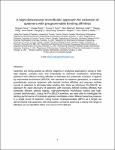A high-dimensional microfluidic approach for selection of aptamers with programmable binding affinities
| dc.contributor.author | Chang, D | |
| dc.contributor.author | Wang, Z | |
| dc.contributor.author | Flynn, CD | |
| dc.contributor.author | Mahmud, A | |
| dc.contributor.author | Labib, Mahmoud | |
| dc.contributor.author | Wang, H | |
| dc.contributor.author | Geraili, A | |
| dc.contributor.author | Li, X | |
| dc.contributor.author | Zhang, J | |
| dc.contributor.author | Sargent, EH | |
| dc.contributor.author | Kelley, SO | |
| dc.date.accessioned | 2023-08-01T10:20:55Z | |
| dc.date.available | 2023-08-01T10:20:55Z | |
| dc.date.issued | 2023-06-05 | |
| dc.identifier.issn | 1755-4349 | |
| dc.identifier.issn | 1755-4349 | |
| dc.identifier.uri | https://pearl.plymouth.ac.uk/handle/10026.1/21118 | |
| dc.description.abstract |
Aptamers are being applied as affinity reagents in analytical applications owing to their high stability, compact size and amenability to chemical modification. Generating aptamers with different binding affinities is desirable, but systematic evolution of ligands by exponential enrichment (SELEX), the standard for aptamer generation, is unable to quantitatively produce aptamers with desired binding affinities and requires multiple rounds of selection to eliminate false-positive hits. Here we introduce Pro-SELEX, an approach for the rapid discovery of aptamers with precisely defined binding affinities that combines efficient particle display, high-performance microfluidic sorting and high-content bioinformatics. Using the Pro-SELEX workflow, we were able to investigate the binding performance of individual aptamer candidates under different selective pressures in a single round of selection. Using human myeloperoxidase as a target, we demonstrate that aptamers with dissociation constants spanning a 20-fold range of affinities can be identified within one round of Pro-SELEX. | |
| dc.format.extent | 773-780 | |
| dc.format.medium | Print-Electronic | |
| dc.language | en | |
| dc.publisher | Nature Research | |
| dc.subject | Humans | |
| dc.subject | Microfluidics | |
| dc.subject | Aptamers, Nucleotide | |
| dc.subject | SELEX Aptamer Technique | |
| dc.subject | Ligands | |
| dc.title | A high-dimensional microfluidic approach for selection of aptamers with programmable binding affinities | |
| dc.type | journal-article | |
| dc.type | Journal Article | |
| dc.type | Research Support, Non-U.S. Gov't | |
| plymouth.author-url | https://www.webofscience.com/api/gateway?GWVersion=2&SrcApp=PARTNER_APP&SrcAuth=LinksAMR&KeyUT=WOS:001000961700001&DestLinkType=FullRecord&DestApp=ALL_WOS&UsrCustomerID=11bb513d99f797142bcfeffcc58ea008 | |
| plymouth.issue | 6 | |
| plymouth.volume | 15 | |
| plymouth.publication-status | Published | |
| plymouth.journal | Nature Chemistry | |
| dc.identifier.doi | 10.1038/s41557-023-01207-z | |
| plymouth.organisational-group | |Plymouth | |
| plymouth.organisational-group | |Plymouth|Faculty of Health | |
| plymouth.organisational-group | |Plymouth|REF 2021 Researchers by UoA | |
| plymouth.organisational-group | |Plymouth|Users by role | |
| plymouth.organisational-group | |Plymouth|Users by role|Academics | |
| plymouth.organisational-group | |Plymouth|REF 2021 Researchers by UoA|UoA01 Clinical Medicine | |
| plymouth.organisational-group | |Plymouth|Faculty of Health|Peninsula Medical School | |
| dc.publisher.place | England | |
| dcterms.dateAccepted | 2023-04-17 | |
| dc.date.updated | 2023-08-01T10:20:31Z | |
| dc.rights.embargodate | 2023-12-5 | |
| dc.identifier.eissn | 1755-4349 | |
| dc.rights.embargoperiod | forever | |
| rioxxterms.versionofrecord | 10.1038/s41557-023-01207-z |


